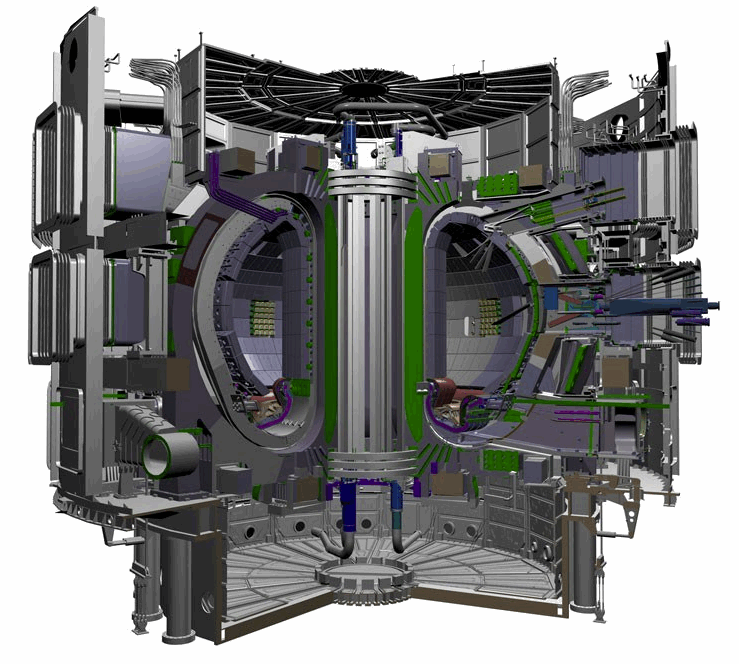The lecture plan will be developed during the semester based upon student interests.
| Lecture Dates |
Topics |
| Jan 20 |
Class cancelled (I will be in Washington, DC on business.)
Please read Marshall Rosenbluth's review of ITER Physics: "Physics fundamentals for ITER" PFCF, 41, A99 (1999) |
| Jan 25 |
Tuesday this week only. (I will be in PPPL at NSTX PAC for normal Thursday class.)
Lecture 1: Introduction to ITER and "Overview and the Status of the ITER Project," by Norbert Holtkamp (Feb 2010).
Read: Shimomura et al. "ITER overview," Nuclear Fusion 39 1291(1999) |
| Feb 3 |
Plasma operational limits, magnetic field strength, and size
"How to design a tokamak fusion reactor"
Read: Hender et al. Chapter 3: MHD stability, operational limits and disruptions. Nucl Fusion (2007) vol. 47 (6) pp. S128-S202
Lecture 2: How to design a burning plasma tokamak? |
| Feb 10 |
Plasma confinement scaling
Lecture-3: "What is the H-mode, and How does it work?"
Read:
|
| Feb 17 |
1st Draft Term-Project Proposals Due
A brief introduction to tokamak engineering and technology
Lecture-4: "How to build the world's most powerful superconducting magnet"
Read:
- Huguet. Key engineering features of the ITER-FEAT magnet system and implications for the R&D programme. Nuclear fusion (2001) vol. 41 (10) pp. 1503
- Okuno et al. Key features of the ITER-FEAT magnet system. Fusion Eng Des (2001) vol. 58-9 pp. 153-157
|
Feb 24 |
Introduction to:
- Tokamak discharge evolution
- Tokamak plasma equilibrium control
- Tokamak MHD instability control
Lecture-5: "Tokamak Discharge Control"
Read:
- Gribov et al. Chapter 8: Plasma operation and control. Nucl Fusion (2007) vol. 47 (6) pp. S385-S403
- Jardin et al. Dynamic modeling of transport and positional control of tokamaks. Journal of Computational Physics (1986) vol. 66 (2) pp. 481-507
- Kessel et al. Development of ITER 15 MA ELMy H-mode inductive scenario. Nuclear Fusion (2009) vol. 49 pp. 085034
|
| Mar 3 |
ITER Diagnostics
Read: Donné et al. Chapter 7: Diagnostics. Nucl Fusion (2007) vol. 47 (6) pp. S337-S384 |
| Mar 10 |
Project 10 minute summaries
- "ITER Operation without Tritium", M. Mauel
- "Resistive Wall Mode Observation and Control", J. Levesque
- "Multiple-scale Turbulences Interaction", Bingqian Li
- "Physics and Design of the Divertor for ITER", C. Stoafer
- "Advanced Tokamaks and ITER", M. Roberts
- "Disruption in ITER: Major Catastrophe or Minor Annoyance?", S. Angelini
- "Vertical Stability Diagonsis and Control in ITER", P. Hughes
- "Heating and Current Drive in ITER", P. Traverso
- "Investigation of Methods and Uses of Auxiliary Heating in ITER-FEAT", P. Byrne
- "Plasma Reconstruction," Q. Peng
- "Battling ELM's in ITER", B. DeBono
- "Energetic Particle Physics in ITER Plasmas", D. Shiraki
- "Toroidal Drift Instabilities", E. Tokluoglu
|
| Mar 17 |
Spring Break
|
| Mar 24 |
Lecture 7: ITER Physics and Technical Issues from the 2007 Design Review
Read: Hawryluk. Principal physics developments evaluated in the ITER design review. Nucl. Fusion (2009) vol. 49 (065012) pp. 065012
Presentations:
- Norbert Holtkamp, "The Design Review", July 11, 2007, Cadarache
- Gunther Janeschitz, "The Status of ITER: The ITER Design Review", Town
Meeting, APS-DPP, October 2007
- Ted Strait, ITPA summary at 12th Workshop on MHD Control, Columbia University, Nov 18, 2007
- Rich Hawryluk, "Principal physics developments evaluated in the ITER design review.", 22nd IAEA Conference on Fusion, 2008
- Hideyuki Takatsu, "Summery on ITER, ...", 23rd IAEA Conference on Fusion, 2010
|
| Mar 31 |
One-on-one discussions about term projects
Issue Cards for student participation during report presenations. |
| Apr 7 |
|
| Apr 14 |
|
| Apr 21 |
|
| Apr 28 |
|
| May 3 |
|
| May 5 |
|
